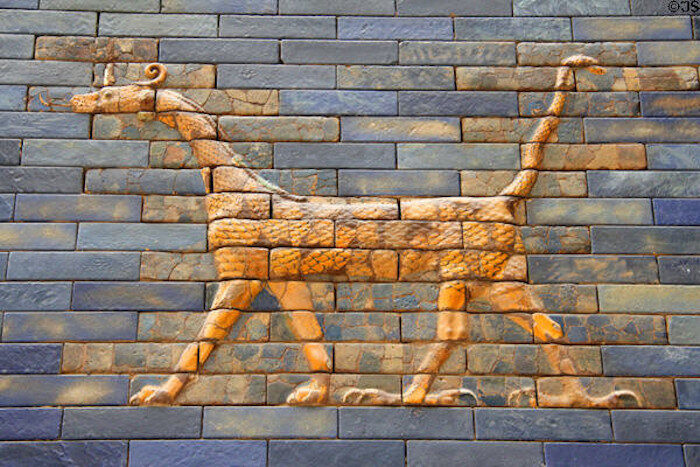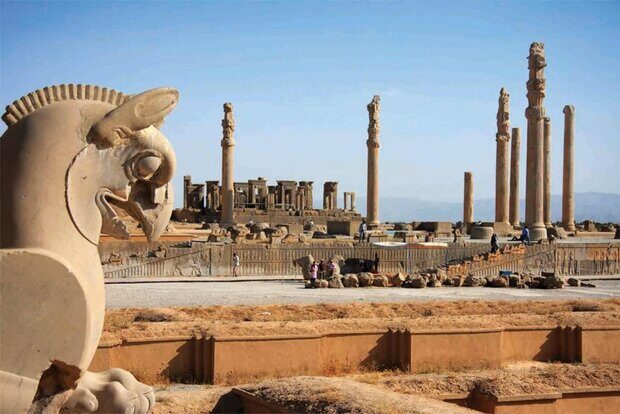
© Tehran Times
The discovery was made near the ruins of a majestic gateway, which is situated adjacent to the UNESCO-registered Persepolis in southern Iran.
The glazed bricks bear motifs of bulls and mushhushshu-dragons, the latter is a mythical creature once popular in ancient Mesopotamia, IRNA reported on Tuesday.
Named Tall-e Ajori, the gateway is made of brick and clay material with its whole exterior decorated with painted bricks.
Narratives say that
mushkhushshu is a mythological hybrid animal with hind legs resembling the talons of an eagle, lion-like forelimbs, a long neck and tail, a horned head, a snake-like tongue, and a crest.
The
Mushkhushshu most famously appears on the reconstructed Ishtar Gate of the city of Babylon, dating to the sixth century BC. In ancient Babylon,
mushhushshu (pronounced "moosh-hoosh-shoo") was a divine creature associated with Marduk, the main god of the city.
Covering 13-ha majestic approaches, monumental stairways, throne rooms (Apadana), reception rooms, and dependencies, Persepolis is classified among the world's greatest archaeological sites.

© Tehran TimesA view of the UNESCO- registered Persepolis in southern Iran.
Persepolis was the seat of the government of the Achaemenid Empire, though it was designed primarily to be a showplace and spectacular center for the receptions and festivals of the kings and their empire. It was burnt by Alexander the Great in 330 BC apparently as revenge to the Persians because it seems the Persian King Xerxes had burnt the Greek City of Athens around 150 years earlier.
The city's immense terrace was begun about 518 BC by Darius the Great, the Achaemenid Empire's king. On this terrace, successive kings erected a series of architecturally stunning palatial buildings, among them the massive Apadana palace and the Throne Hall ("Hundred-Column Hall").
The site is marked by a large terrace with its east side abutting the Kuh-e Rahmat ("Mount of Mercy"). The other three sides are formed by a retaining wall, varying in height with the slope of the ground from 13 to 41 feet (4 to 12 meters); on the west side, a magnificent double stair in two flights of 111 short stone steps leads to the top. On the terrace are the ruins of several colossal buildings, all constructed of a dark gray stone (often polished to a marble-like surface) from the adjacent mountain.
According to Britannica, the stone was cut with the utmost precision into blocks of great size, which were laid without mortar; many of them are still in place. Especially striking are the huge columns, 13 of which still stand in the audience hall of Darius I (the Great; reigned 522-486 BC), known as the Apadana, the name given to a similar hall built by Darius at Susa. There are two more columns still standing in the entrance hall of the Gate of Xerxes, and a third has been assembled there from its broken pieces.
In 1933 two sets of gold and silver plates recording in the three forms of cuneiform — ancient Persian, Elamite, and Babylonian — the boundaries of the Persian empire were discovered in the foundations of Darius's hall of audience. Several inscriptions, cut in stone, of Darius I, Xerxes I, and Artaxerxes III indicate to which monarch the various buildings were attributed.
Greek and Roman historians described how Achaemenid buildings were covered in spectacular amounts of gold. Persepolis alone is said to have contained 2,500 tonnes of it. Herodotus wrote that Achaemenid soldiers 'glittered all over with gold, vast quantities of which they wore about their person'.
Reader Comments
Because there is history there that's awkward to the current set of historic lies agreed upon..thats why
You know there is something to it, when you don't hear about research on it, just the New Age monatomic gold in a bottle snake oil. When I first read about it, early 2000's was right around the time central banks were selling off gold reserves, when the prices were low, not high. Laurence Gardner was the author, I have a couple of his books. His books in a sense reminded me of Stitchin, in that he has some truths in them and the rest is speculative, but interesting. Preconditioning. His books, was one of the reasons I started to reread the bible. Back check what he was saying. A bit of a shady character, he was for sure.
So history rewrites itself for the western World. Full of suppositions, conjectures and analogy. But in reality, nobody knows, nobody lives, there is scant records, from that date and time, and if it exist, it is controlled, so that the plebs, will never know the truth, just those in the know.
Makes me wonder, is anything that is presented as wold history from MSM the truth, in this day and age. After all what is present as truth one day, is presented as lies another day. And that is in just 24 hours
[Link] Ishtar Gate
This disbelief comes from inaccuracies in accounting by those privileged to report on such matters, even Einstein and his work is been dismantled and within a few years new theories will replace his outdated reasoning.
Take Darwin as an example, a titan in his time, now relegated to the bottom of the pile in evolutionary thinking.
There is a reason for this awakening.
When folk ars told lies /misinformation, they lose faith in the system and wish to know the truth.
Darwin nor Einstein lied, nor did they deliberately spread misinformation, they are victims of technology and its advancement.
Yet others do bend the truth and that's unexceptable.
the ishtar gate is there in berlin allright. (so is the bust of neferititi )
as i recall it, hitler himself had a grand vision of making berlin museum the most supreme museum of the world.
(he did not differ much from the brits, americans, french, etc there )
"Dinosaurs" still existed, until the Earth left the Sun. We then got the cold polar regions and the torrid zone. Then Venus was born of the sun, lucifer thrown out of heaven. We were sent further away into current orbit.
It would be lovely if we could warm up our planet by burning carbon fuels, but it ain't so!
[Link]
[Link]